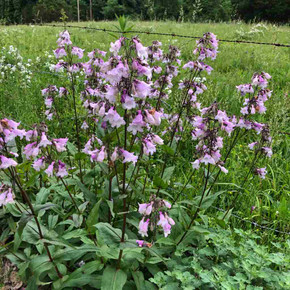
Digitalis grandiflora - YELLOW FOXGLOVE
This clump-forming perennial is a favorite of pollinators and hummingbirds. It has evergreen foliage, with deep green, finely-toothed leaves that are quite large at the basal rosettes and smaller in size higher up the stem. It is fairly short-lived, as individual plants last 4-5 years, though this could be considered long-lived compared to other plants in the Digitalis genus. It will self-seed quite readily, but is not invasive. The pale yellow flowers are up to 2" long with brown markings inside, and appear in early to midsummer.
It's common practice to cut the flowering spikes back once they're done blooming to improve the appearance of the plant and promote future growth; removing them can also encourage a second bloom later in the season. However, a few of the spent spires must be left undisturbed if you wish for the plant to self-seed.
Perfect for the middle or back of flower beds in the sun or half shade, ornamental borders, woodland gardens, cottage garden, and naturalized along woodland edge. It is a quite narrow plant that offers a striking vertical accent, particularly when placed in front of a dark background, and can be squeezed among many common perennials. It makes a wonderful cut flower (pick when the blooms are half open).
Yellow Foxglove is relatively drought tolerant once established, but does not transplant easily once mature. It will not tolerate wet soil in winter. It suffers from no serious disease or insect troubles, but keep an eye out for aphids, Japanese beetles, leaf spot, and powdery mildew. When it received the Award of Garden Merit from the Royal Horticultural Society in 1993, this foxglove was rated as hardy in very cold winters -20°C to -15°C (-4°F to 5°F).
All parts of the plant are highly toxic to humans, dogs, cats, and horses if ingested; the toxicity is caused by compounds that have been used medicinally, both historically and in modern applications.
Blooming Time: May - June, sporadically up to July
Size: 2-3' tall (flower spikes) x 1.5' wide
USDA Zones: 3 to 8
Culture: full sun to part shade, average to organically rich, and well-drained soils
Moisture Needs: average, prefers consistent moisture
Origin: the native range stretches from central Europe to Turkey and Siberia, where D. grandiflora can be found growing in woods, along stream banks, on warm mountain slopes, and in old logging areas.
Deer/Rabbit Resistant: yes / yes
Attracts Butterflies or Pollinators: yes / yes
Attracts Hummingbirds: yes, plus other small birds eat the seeds
Pot Size: square 3.5" x 5" deep pot
Picture Copyright: Salicyna, Commons Wikipedia

Digitalis grandiflora - YELLOW FOXGLOVE
This clump-forming perennial is a favorite of pollinators and hummingbirds. It has evergreen foliage, with deep green, finely-toothed leaves that are quite large at the basal rosettes and smaller in size higher up the stem. It is fairly short-lived, as individual plants last 4-5 years, though this could be considered long-lived compared to other plants in the Digitalis genus. It will self-seed quite readily, but is not invasive. The pale yellow flowers are up to 2" long with brown markings inside, and appear in early to midsummer.
It's common practice to cut the flowering spikes back once they're done blooming to improve the appearance of the plant and promote future growth; removing them can also encourage a second bloom later in the season. However, a few of the spent spires must be left undisturbed if you wish for the plant to self-seed.
Perfect for the middle or back of flower beds in the sun or half shade, ornamental borders, woodland gardens, cottage garden, and naturalized along woodland edge. It is a quite narrow plant that offers a striking vertical accent, particularly when placed in front of a dark background, and can be squeezed among many common perennials. It makes a wonderful cut flower (pick when the blooms are half open).
Yellow Foxglove is relatively drought tolerant once established, but does not transplant easily once mature. It will not tolerate wet soil in winter. It suffers from no serious disease or insect troubles, but keep an eye out for aphids, Japanese beetles, leaf spot, and powdery mildew. When it received the Award of Garden Merit from the Royal Horticultural Society in 1993, this foxglove was rated as hardy in very cold winters -20°C to -15°C (-4°F to 5°F).
All parts of the plant are highly toxic to humans, dogs, cats, and horses if ingested; the toxicity is caused by compounds that have been used medicinally, both historically and in modern applications.
Blooming Time: May - June, sporadically up to July
Size: 2-3' tall (flower spikes) x 1.5' wide
USDA Zones: 3 to 8
Culture: full sun to part shade, average to organically rich, and well-drained soils
Moisture Needs: average, prefers consistent moisture
Origin: the native range stretches from central Europe to Turkey and Siberia, where D. grandiflora can be found growing in woods, along stream banks, on warm mountain slopes, and in old logging areas.
Deer/Rabbit Resistant: yes / yes
Attracts Butterflies or Pollinators: yes / yes
Attracts Hummingbirds: yes, plus other small birds eat the seeds
Pot Size: square 3.5" x 5" deep pot
Picture Copyright: Salicyna, Commons Wikipedia
Customer Reviews
-
YELLOW FOXGLOVE
shipping containers are great and plants arrive looking healthy. Are looking good having been planted.










